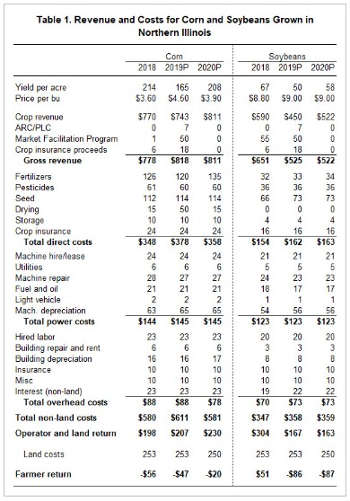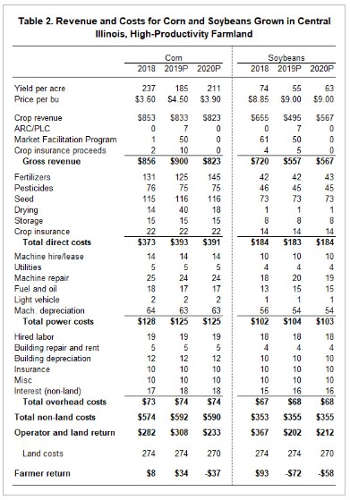By Gary Schnitkey and Krista Swanson
Department of Agricultural and Consumer Economics
University of Illinois
Crop budgets for 2020 have been released and made available on farmdoc. In addition, 2019 budgets have been revised in light of wet weather and late planting. Overall, low returns are projected in 2019 and 2020, particularly for soybeans. Current projections indicate corn returns will be higher than soybean returns.
Background
Historical results and budgets are maintained for Illinois farms in four regions:
- Northern Illinois.
- Central Illinois with high productivity farmland (Central-high). From 2013 to 2018, central-high farms averaged 220 bushels per acre for corn.
- Central Illinois with low-productivity farmland (Central-low). From 2013 to 2018, central-high farms averaged 207 bushels per acre for corn.
- Southern Illinois.
Actual values are summarized from farms enrolled in Illinois Farm Business Farm Management (FBFM). FBFM is an accounting and financial consulting cooperative servicing over 5,000 farms representing around 25% of the acres farmed in Illinois. Actual results have been finalized for 2018. These results are summarized for corn, soybean, wheat, and double-crop soybeans for the years from 2013 to 2018 in a publication entitled Revenue and Cost for Illinois Crops available for download from the farmdoc website. The format of the document is illustrated in Table 1, which shows actual 2018 results, and projections for 2019 and 2020 for northern Illinois.

In addition to 2018 actual values, 2019 crop budgets have been revised and are available for download from farmdoc. Major revisions occur because of the unprecedented wet spring weather and late planting in 2019. The following values have been changed since the initial release:
- The 2019 yields have been lowered. How much to lower yields is an open question, and will be much influenced by remaining weather and growing conductions. For northern Illinois a 165 bushel yield is used for 2019, down from an actual yield of 214 bushels per acre in 2018 (see Table 1). Yields could be lower than the 165 estimate. However, further lowering yields from that point will have little influence on total returns, as lower yields will result in higher crop insurance payments that will counter lower crop revenue.
- Crop prices for 2019 have been raised to $4.50 per bushel for corn and $9.00 for soybeans (see Table 1). Further price changes will be highly influenced by clearer estimates of yields and planted acres.
- Market Facilitation Program (MFP) payments of $50 per acre have been added to 2019 budgets. The U.S.D.A. will distribute MFP payments in 2019, to be paid on planted acres. Rates will not vary whether acres are planted to corn or soybeans. Per acre payment rates have not been released, the $50 per acre payment in the 2019 budgets is an estimate. Actual payment rates may be higher or lower.
- Crop insurance proceeds have been increased to reflect lower yields and higher prices
- Drying costs for corn have been increased from the usual $15 per acre up to $50 per acre, reflecting likelihood for harvest at higher moisture levels and increased need for drying that will occur this fall.
Moreover, the first release of 2020 Illinois Crop Budgets have been made and are available on farmdoc. For 2020, yields are at the trend-line levels: 208 bushels per acre for corn and 58 bushels per acre for soybeans in northern Illinois. Projected prices are $3.90 per bushel for corn and $9.00 per bushel for soybeans. Actual prices will vary from projections.
In Table 1, operator and land return is the financial return remaining for paying farmland costs and providing a return to farmers. Land costs in Table 1 are average cash rents in northern Illinois, $253 per acre in 2018 and 2019. Cash rents are projected at $250 per acre in 2020. Land costs on owned land will include the real estate taxes and interest, if mortgaged. Farmer return is amount remaining after all non-land and land costs have been subtracted from gross revenue. This farmer return value provides for family living, repayment of debt, and equity funding for capital purchases.
Northern Illinois
Northern Illinois is one of the hardest hit areas with wet weather and delayed planting, and could have lower returns than other regions. For corn, farmer return is projected to be less negative in 2019 as compared to 2018: -$47 per acre in 2019 and -$56 in 2018. Note that 2019 returns would be -$97 per acre without inclusion of a MFP payment of $50 per acre. Farmer return is projected at -$20 per acre in 2020.
For soybeans, farmer return was $51 per acre in 2018. Exceptional yields of 61 bushel per acre and MFP payments of $55 per acre contribute to the positive returns in 2018. Farmer returns are projected at -$86 per acre for 2019, a decline of $137 per acre form the 2018 level. Note that 2019 returns would be -136 per acre without the inclusion of a MFP payment of $50 per acre. Yields in 2019 are projected to average 50 bushels per acre, down by 17 bushels per acre from 2018 levels. For 2020, soybean returns are projected at -$87 per acre, roughly the same level as 2019 projected returns. Revenue from higher yields (58 bushels per acre in 2020 versus 50 bushels per acre in 2019) is offset by the expectation for $0 MFP payments in 2020.
Central Illinois – High Productivity
For comparison to northern Illinois, central-high returns are shown in Table 2. The central-high region had exceptional yields in 2018: 237 bushels per acre for corn and 74 bushels per acre for soybeans. Current projections place 2019 yields at 185 bushel per acre for corn and 55 bushels per acre for soybeans. Corn returns are projected at $34 per acre in 2019, as compared to $8 per acre in 2018. Lower yields are offset by higher prices, a higher MFP payment, and crop insurance proceeds. Soybean returns are reduced from $93 in 2018 to -$72 in 2019. Lower yields contribute to the lower returns. The strong soybean yields in 2018 also resulted in MFP payments for soybeans that exceed the expectation for the per acre MFP payment in 2019.

Summary
At this point, overall returns on Illinois grain farms are projected to be much lower in in 2019 than in 2018. Soybean returns are projected to fall by over a $100 in northern and central Illinois. Better than expected yields, higher prices, or some combination could result higher 2019 projected returns.
Projected returns remain low in 2020, a result of lower prices and no MFP payments.
Given the unusually late growing season, most Illinois crops have yet to reach, or are just now reaching, reproductive stages. In addition to the impact of weather on yield during these critical stages, there are many other economic and political factors can continue to influence price. Much can change in 2019 and 2020. Revisions to these budgets will occur as more information becomes available.
Source: farmdocdaily